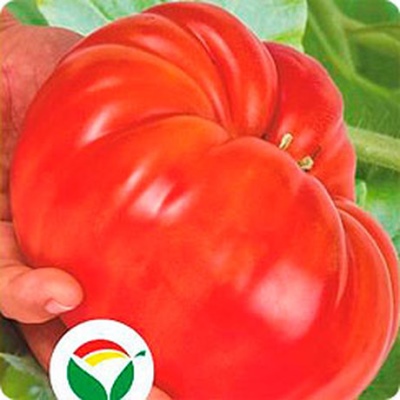
- Authors: Russia
- Category: grade
- Growth type: semi-determinant
- Appointment: fresh consumption
- Ripening period: mid-season
- Ripening time, days: 105-110
- Growing conditions: for open ground, for closed ground
- Bush height, cm: up to 170
- Ripe fruit color: pink
- Fruit shape: flat-round
The semi-determinant variety of tomatoes of the Russian selection, Siberian Bast Shoes, was created by specialists taking into account regional climatic features. It is well suited for indoor and outdoor planting, provides excellent yields, and fully ripens during the short warm season. The originator is the agrofirm "Siberian Garden".
Description of the variety
Bushes up to 170 cm high form strong, strong shoots. Moderate leafiness, thinning of the tops is not required. Inflorescences are laid in 1-2 leaves, simple in structure.
The main qualities of the fruit
Tomatoes are large, weighing 350-500 g. The color of the skin is pink, the shape is flat-round, resembling a bast shoe. The pulp is fleshy, quite dense. Fruits are ribbed, well-defined.
Taste characteristics
The sweet pulp and firm skin of tomatoes provide an excellent combination of flavors. The fruits are especially good when fresh.
Ripening and fruiting
The variety is mid-season. You can start harvesting in 105-110 days.
Yield
Fruit collection rates reach 12 kg / sq. m.
The timing of planting seedlings and planting in the ground
Sowing seeds begins 2 months before planting in a permanent place. Germination is recommended at a temperature not lower than +23 degrees Celsius. It is best to start it in March. Then, already in May-June, it will be possible to start transferring seedlings to open ground.

Growing tomato seedlings is an extremely important process, because it largely depends on whether the gardener can harvest at all. All aspects must be taken into account, from seedbed preparation to planting in the ground.
Landing scheme
For 1 sq. m have 2-3 plants. 30 cm are left between them, the row spacing is 40 cm.

Growing and care
The Siberian bast tomato is grown with 2-3 stems. In the open field, you can form it into 1 central shoot. As it grows, the bush is tied up. Heavy fruits on the hands need an extra garter. Immediately after transplanting, even in the open field, young bushes are covered at night.
Tall bushes need regular watering. Young plants do not require much moisture, but when the fruit is set and ripened, it is performed every other day if the weather is hot. The rest of the time, 2-3 times a week will be enough. Before this, the soil is weeded and loosened, improving air access to the roots. In regions with hot summers, it is worth using natural mulch made from straw or sawdust, peat - this will prevent drying out.
Top dressing is also important.Fleshy and strong, reaching the maximum mass, the fruits will be only if they receive enough potassium and phosphorus during the growth period. Mineral complexes suitable for tomatoes can be selected in liquid or granular form. It is undesirable to overfeed tomatoes of this variety with nitrogen - this will negatively affect fruiting, increase the intensity of the formation of stepchildren.




A plant needs different micronutrients at each stage of growth. All fertilizers can be divided into two groups: mineral and organic. Folk remedies are often used: iodine, yeast, bird droppings, eggshells.
It is important to observe the rate and period of feeding. This also applies to folk remedies and organic fertilizers.
Disease and pest resistance
Tomatoes in greenhouses require humidity control. Otherwise, they can be affected by fungal infections. The causative agents of Alternaria and late blight are especially dangerous for bushes. Preventive treatments are carried out with Ordan fungicide or its analogues. It is necessary to start spraying at the seedling stage, with 4-6 true leaves, then the procedure is repeated at intervals of 10 days, completing it 3 weeks before harvesting the fruits.


Resistant to adverse weather conditions
The variety is cold-resistant. It tolerates temperature changes well, can grow in partial shade. Lower temperatures do not affect the intensity of fruit setting.
Growing regions
The tomato is zoned for cultivation in Siberia.
Review overview
Tomatoes of the Siberian Bastard variety invariably cause an enthusiastic reaction from those who plant this tomato for the first time in their area. Summer residents notice that the fruits are very large, fleshy, rich in taste and juice. They are successfully turned into sauces or juices, added to fresh salads and other dishes. Vegetable growers advise not to forget that even this unpretentious variety needs care. Tomato bushes will have to be pinned periodically, to support ripening fruit clusters, to regulate watering - so it will be possible to achieve the declared yield indicators.
There are few disadvantages of Siberian bast shoes. Of the reasons for dissatisfaction found by vegetable growers, one can single out not 100% seed germination, but also difficulties with the purchase of material. And also the bushes in the greenhouse are not too well protected from late blight, they need constant spraying. With a lack of watering, the fruits are smaller, not so tasty.

























































































